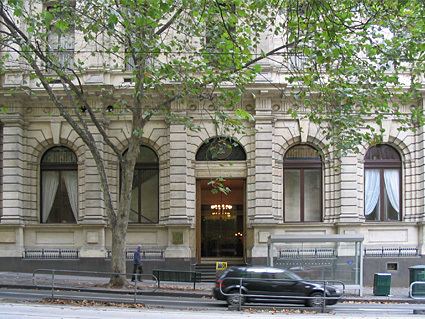Type Bank Country Australia Renovated 1929, 1970 Architectural style Neoclassical architecture Town or city Melbourne, Victoria | Address 394-398 Collins Street Completed 1881 Opened 1881 Construction started 1876 Architect Joseph Reed | |
 | ||
Current tenants Residential and Apartments at Melbourne Similar Scots' Church - Melbourne, St Michael's Uniting C, Coffee palace, Government House - Melbourne, City Square - Melbourne | ||
The Former Bank of Australasia building is a neoclassical structure located in the Melbourne city centre. It stands on the corner of Queen Street and Collins Street, right in the centre of the Melbourne banking and offices precinct. The five-storeys building had played an integral part in Melbourne’s economy during the Gold rush and the great depression. It was designed by Reed and Barnes architect and constructed in 1876.
Contents
- Map of Former Bank of Australasia Melbourne VIC 3004 Australia
- Design approach
- Significance
- Awards
- References
Map of Former Bank of Australasia, Melbourne VIC 3004, Australia
The building has gone under two renovations, with the first renovation being done by A&K Henderson between 1929–30 and the second being an interior renovation in 1970. The Former Bank of Australasia building was the main headquarters of the Bank of Australasia between 1876-1974. It is now a private apartment building known as Treasury on Collins.
Design approach
The Former Bank of Australasia can be categorized as a neoclassical building. It was an architectural style mostly used in the 1800s. Built in a superimposed trabeated system, the building lack of ornamental design and its usage of the Doric order read strength and solidity, personalities that define the rapid growth of Melbourne’s (Port Philip) economy during the 1870s. Reed and Barnes initial design was for a two storeys building. The building was 20.7 meters high and occupied 890 square meters area of land1. The exterior of the building is similar to any other trabeated building, exposing pilasters that carry the main cornices and parapets. The façade was clothed with Oamaru free stone imported from New Zealand, and the basement was constructed of Malmesbury stone.
The interior was designed in a typical bank design of the time, with the ground floor being the main chamber and offices space. The only public entrance was through Collins Street. It was paved in stone to differentiate the public and the private (tenants) spaces. The basement was mainly occupied by the bank’s vault (strong rooms), while two smaller vaults were put on the ground floor to help the daily business of the bank. Offices and rooms for the clerks occupied the top floor.
The first renovation took place in 1929, during the great depression. The building area was multiplied by adding three extra storeys on top of the two 3. It was a typical design move during that period, as constructing a new building was too expensive. The three storeys were designed according to the first two, except for the small setback on the fifth floor façade. It was also built in the same materials as the previous two storeys. The interior was fully renovated; a light well was put through the centre of the building, enabling skylight to puncture through to the main floor. The ornamental details were designed in the Renaissance Revival style, using plasters as the main material. The 1970 minor renovation saw the light well closed and the addition of two intermediate floors between the first and second floor, and between the third and fourth floor.
Significance
The superimposed trabeated system applied on the building is an architectural significance, as it is the main characteristic of neoclassical architecture. Beside that, the unusual rusticated triple Doric order facade and groups of square pilasters were one of the earliest design approach applied in a building. The building’s position in the corner of Queen Street and Collins Street also played part in the significance of its appearance, creating a three dimensional impression only by constructing two two-dimensional façades with protruded pilasters and cornices. The interior design of the Former Bank of Australasia is also significant for its reflection of the banking activities hierarchy at that period, with an unusual placement of a boardroom inside a bank.
Awards
The Former Bank of Australasia is listed as one of Victoria’s heritage building by the Australian Heritage Commission in 1983, on article number one under the category of heritage premises. The current building is also registered by the National Trust of Australia as a heritage of the Bank of Australasia.
